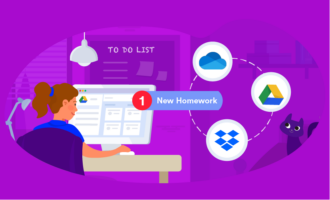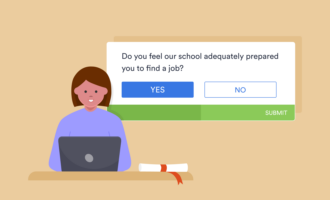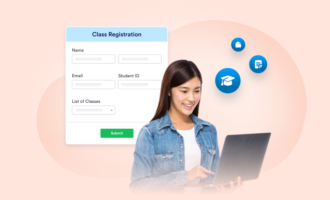School administrators and teachers love data because it can be used in many helpful ways.
Educators can learn more about their students, gather feedback on different teaching styles, and better understand how students are doing emotionally.
Teachers may know how to administer student feedback forms, but they may not know the best way to share their findings with colleagues. Unfortunately, surveys can’t be effective if they aren’t transformed into actionable information and shared among staff.
To transform your school’s raw data into a shared, actionable narrative, you just need to follow a few simple steps.
Pro Tip
For an insightful look into the future of higher education, explore “8 Top Trends in Higher Education to Watch in 2024” on Jotform’s blog.
Lay the groundwork first
Data can be a valuable tool for educators — but before administering surveys, teachers and leaders need to be on the same page regarding attitudes and expectations toward student data.
“I think anybody who is a first- or second- or third-year teacher or administrator feels some anxiety around data conversations,” says educator Justin Tarte, Ed.D. “Communicate openly about what the purpose of a conversation about data is, and make it clear you’re on the same team.” Teachers need to know what type of data they are expected to collect and how it will be used.
Once teachers understand how that data will translate into better teaching practices, policy decisions, and resource acquisition or allocation, they will be motivated to collect and share their information.
Set up a solid foundation for data sharing and collaboration by establishing clear expectations and defining the procedures. “There is an art to good survey design that can help you to get better, more actionable data,” says media specialist and teacher librarian Diana Rendina. When teachers feel confident in their ability to create strong surveys, they’ll also be more likely to share their forms and results with others.
If you use the same terms consistently and track the same data year after year, you’ll be able to compare yearly results and track the progress of the actions you’re implementing. If surveys are in a format that you can repeatedly use and share, there will be no need to reinvent the wheel — you’ll already have consistent ways to measure your data.
To prepare teachers for data collection, administrators should provide them with easy-to-use survey templates and sample questions. They should be taught how to administer these surveys as well as what types of feedback they’ll be expected to be shared with the administration. It’s also crucial that teachers know exactly how and when to share data with colleagues.
Pro Tip
Start collecting data with Jotform! Conduct online student surveys and questionnaires and instantly share the results with your colleagues — for free.
Choose a consistent communication platform
Once you’ve set up clear expectations and guidelines, you can dive straight into the mechanics of collecting the data you’re after.
Digital forms are a simple and efficient way to collect data securely. At Jotform, your forms are protected with the same level of security that online bankers and e-commerce brands use to protect their customers. Forms can also be encrypted to ensure the highest level of privacy for your students.
You can even integrate with trusted cloud storage platforms, such as Google Drive and Dropbox, to securely store the data gathered via your online forms.
If you’d rather stick with your current data management system, “you probably already have the tools to connect with colleagues and share ideas in an online community tailored to your district or school,” says Lauren Davis at Schoology. “Your LMS [learning management system] is the perfect place to create common assessments, track student data, share resources, and keep assignments.”
No matter which platform you use, online survey results are best shared via a consistent communication platform that all colleagues use regularly. Otherwise, you risk your communication being unorganized and unreliable.
Visualize your data
Data needs to be digestible in order to be compelling and, more important, to be turned into action.
“Data is just a collection of numbers until you turn it into a story,” says Nicole Martin, digital marketer and host of the Talk Digital To Me podcast. “Showing reports and dashboards can be overwhelming without adding a narrative to the data.” Turning your data into a story doesn’t have to be complicated. It can be as simple as converting numbers into a bar chart and adding a short description.
Making bar charts may not have been what you signed up for when you became an educator — but there are many ways to easily convert data into visuals. Tools like JotPoll automatically turn form responses into custom poll results. The simple visual of a poll makes results much easier to understand and share with colleagues.
There are several online tools that securely convert data into charts or infographics. Be sure to work with colleagues and administrators to decide which tools serve your team best.
Don’t go overboard
Remember — the goal of data collection and sharing is to help improve schools and student learning.
Teachers already have a heavy workload, and too much data can add to that stress. Administrators in particular need to be careful not to overload teachers with excessive data.
“Be patient with growth, stop creating initiative overload, and root everything you do in durable anchors that help avoid pointless professional development” writes Drew Perkins, TeachThought’s director of professional development. Data can provide great insight on the overarching story of your school’s performance, but it can’t override every lesson or a teacher’s gut feeling about their next move in class.
After collecting data, be selective about what you share with other teachers. By focusing on what really matters, you’ll find the right balance between a school culture dictated by data and one influenced by data.









































































































Send Comment: